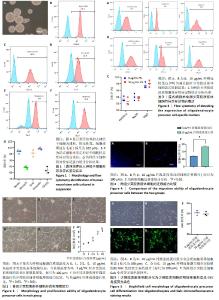[1] TANG X, WANG Z, WANG M, et al. Nanoarchitectonics of cellulose nanocrystal conjugated with a tetrasaccharide-glycoprobe for targeting oligodendrocyte precursor cells. Carbohydr Polym. 2023;317:121086.
[2] FANG M, CHEN L, TANG T, et al. The committed oligodendrocyte precursor cell, a newly-defined intermediate progenitor cell type in oligodendroglial lineage. Glia. 2023;71(11):2499-2510.
[3] LEE KK, DE REPENTIGNY Y, SAULNIER R, et al. Dominant-negative beta1 integrin mice have region-specific myelin defects accompanied by alterations in MAPK activity. Glia. 2006;53(8):836-844.
[4] HU J, DENG L, WANG X, et al. Effects of extracellular matrix molecules on the growth properties of oligodendrocyte progenitor cells in vitro. J Neurosci Res. 2009;87(13):2854-2862.
[5] MONACO MC, MARIC D, BANDEIAN A, et al. Progenitor-derived oligodendrocyte culture system from human fetal brain. J Vis Exp. 2012;(70):4274.
[6] RIESKE P, AUGELLI BJ, STAWSKI R, et al. A population of human brain cells expressing phenotypic markers of more than one lineage can be induced in vitro to differentiate into mesenchymal cells. Exp Cell Res. 2009;315(3):462-473.
[7] DALTON CJ, LEMMON CA. Fibronectin: Molecular Structure, Fibrillar Structure and Mechanochemical Signaling. Cells. 2021;10(9):2443.
[8] MORIYA K, SAKAI K, YAN MH, et al. Fibronectin is essential for survival but is dispensable for proliferation of hepatocytes in acute liver injury in mice. Hepatology. 2012;56(1):311-321.
[9] BONADIO JD, BASHIRI G, HALLIGAN P, et al. Delivery technologies for therapeutic targeting of fibronectin in autoimmunity and fibrosis applications. Adv Drug Deliv Rev. 2024;209:115303.
[10] AHN S, SHARMA U, KASUBA KC, et al. Engineered Biomimetic Fibrillar Fibronectin Matrices Regulate Cell Adhesion Initiation, Migration, and Proliferation via α5β1 Integrin and Syndecan-4 Crosstalk. Adv Sci (Weinh). 2023;10(24):e2300812.
[11] VAN SCHAIK PEM, ZUHORN IS, BARON W. Targeting Fibronectin to Overcome Remyelination Failure in Multiple Sclerosis: The Need for Brain- and Lesion-Targeted Drug Delivery. Int J Mol Sci. 2022; 23(15):8418.
[12] STOFFELS JM, HOEKSTRA D, FRANKLIN RJ, et al. The EIIIA domain from astrocyte-derived fibronectin mediates proliferation of oligodendrocyte progenitor cells following CNS demyelination. Glia. 2015;63(2): 242-256.
[13] BARON W, COLOGNATO H, FFRENCH-CONSTANT C. Integrin-growth factor interactions as regulators of oligodendroglial development and function. Glia. 2005;49(4):467-479.
[14] CHUDAKOVA DA, ZEIDAN YH, WHEELER BW, et al. Integrin-associated Lyn kinase promotes cell survival by suppressing acid sphingomyelinase activity. J Biol Chem. 2008;283(43):28806-28816.
[15] MA W, TAVAKOLI T, DERBY E, et al. Cell-extracellular matrix interactions regulate neural differentiation of human embryonic stem cells. BMC Dev Biol. 2008;8:90.
[16] LONGSTRETH JH, WANG K. The role of fibronectin in mediating cell migration. Am J Physiol Cell Physiol. 2024;326(4):C1212-C1225.
[17] GUERRERO-BARBERÀ G, BURDAY N, COSTELL M. Shaping Oncogenic Microenvironments: Contribution of Fibronectin. Front Cell Dev Biol. 2024;12:1363004.
[18] MARTINUCCI B, CUCIELO MS, MINATEL BC, et al. Fibronectin Modulates the Expression of miRNAs in Prostate Cancer Cell Lines. Front Vet Sci. 2022;9:879997.
[19] WEBB DJ, PARSONS JT, HORWITZ AF. Adhesion assembly, disassembly and turnover in migrating cells -- over and over and over again. Nat Cell Biol. 2002;4(4):E97-100.
[20] BANDZEREWICZ A, GADOMSKA-GAJADHUR A. Into the Tissues: Extracellular Matrix and Its Artificial Substitutes: Cell Signalling Mechanisms. Cells. 2022;11(5):914.
[21] STEPP MA, ZHU L, SHEPPARD D, et al. Localized distribution of alpha 9 integrin in the cornea and changes in expression during corneal epithelial cell differentiation. J Histochem Cytochem. 1995;43(4): 353-362.
[22] ANLAR B, ATILLA P, CAKAR AN, et al. Expression of adhesion and extracellular matrix molecules in the developing human brain. J Child Neurol. 2002;17(9):707-713.
[23] FLANAGAN LA, REBAZA LM, DERZIC S, et al. Regulation of human neural precursor cells by laminin and integrins. J Neurosci Res. 2006; 83(5):845-856.
[24] TATE MC, SHEAR DA, HOFFMAN SW, et al. Fibronectin promotes survival and migration of primary neural stem cells transplanted into the traumatically injured mouse brain. Cell Transplant. 2002;11(3): 283-295.
[25] MOORE L, SKOP NB, ROTHBARD DE, et al. Tethered growth factors on biocompatible scaffolds improve stemness of cultured rat and human neural stem cells and growth of oligodendrocyte progenitors. Methods. 2018;133:54-64.
[26] LAFRENAYE AD, FUSS B. Focal adhesion kinase can play unique and opposing roles in regulating the morphology of differentiating oligodendrocytes. J Neurochem. 2010;115(1):269-282.
[27] XIONG YJ, SOOMRO SH, HUANG ZH, et al. Poly-L-ornithine blocks the inhibitory effects of fibronectin on oligodendrocyte differentiation and promotes myelin repair. Neural Regen Res. 2023;18(4):832-839.
[28] TO WS, MIDWOOD KS. Plasma and cellular fibronectin: distinct and independent functions during tissue repair. Fibrogenesis Tissue Repair. 2011;4:21.
[29] EYERMANN C, CZAPLINSKI K, COLOGNATO H. Dystroglycan promotes filopodial formation and process branching in differentiating oligodendroglia. J Neurochem. 2012;120(6):928-947. |

